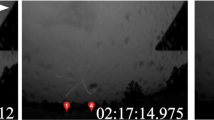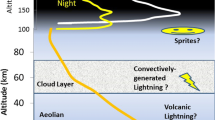Summary
We have used a CGR3 lightning flash counter to gather lightning type and occurrence data over five complete years in Gaborone, Botswana. The results show that the mean ground flash density is 4.6 km−2 yr−1. Of these, 4.9% of ground flashes lower a net positive charge. The overall ratio of intracloud flashes to ground flashes is 1.9, the value being slightly higher during the nights than the daytime. A typical lightning season lasts from September to May, the activity reaching a peak between November and January. There is virtually no lightning at all during the dry winter months of June, July and August. The number of flashes per storm shows a marked decrease as the season progresses. In the diurnal cycle, the peak lightning activity occurs at around 19 h, which is somewhat late when compared with most other locations. However, together with observations in the Central United States, it seems to suggest that the peak activity occurs later in the day at mid-continental locations.
Similar content being viewed by others
References
Baral, K. N., Mackerras, D., 1992: The cloud flash to ground flash ratio and other lightning occurrence characteristics in Kathmandu thunderstorms.J. Geophys. Res.,97, 931–938.
Bhalotra, Y. P. R., 1987:Climate of Botswana. Dept. of Meteorol. Services, Gaborone, Botswana, Internal Report.
Easterling, D. R., Robinson, P. J., 1985: The diurnal variation of thunderstorm activity in the United States.J. Climate Appl. Meteor.,24, 1048–1058.
Eriksson, A. J., 1976: The measurement of lightning and thunderstorm parameters: results for the 1975/76 season, CSIR special report ELEK 103, Pretoria, RSA.
Finke, U., Hauf, T., 1996: Characteristics of lightning distribution in Southern Germany.Proc. 10th. Int. Conf. Atmos. Electr., Osaka, Japan, 380–383.
Jayaratne, E. R., 1993: Conditional instability and lightning activity in Gaborone, Botswana.Meteorol. Atmos. Phys.,52, 169–175.
Kotaki, M., Katoh, C., 1983: The global distribution of thunderstorm activity observed by the ionosphere sounding satellite (ISS-b)J. Atmos. Terr. Phys.,45, 833–847.
Kroninger, H., 1982: Newsletter-national lightning recording scheme. CSIR special report ELEK 253. Pretoria, South Africa.
Mackerras, D., 1985: Automatic short-range measurement of the cloud flash to ground flash ratio in thunderstorms.J. Geophys. Res.,90, 6195–6201.
Mackerras, D., Darveniza, M., 1992: Design and performance of CGR3 instruments for measuring the cloud flash to ground flash ratio in thunderstorms. Univ Queensland, Dept Elec Eng, Report no EE92/2.
Mackerras, D., Darveniza, M., 1994: Latitudinal variation of lightning occurrence characteristics.J. Geophys. Res.,99, 10,813–10,821.
Mackerras, D., Darveniza, M., Orville, R. E., Williams, E. R., Goodman, S. J., 1996: Global lightning total, cloud and ground flash estimates.J. Geophys. Res. (submitted).
Maier, L. M., Krider, E. P., Maier, M. W., 1984: Average diurnal variation of summer lightning over the Florida peninsula.Mon. Wea. Rev.,112, 1134–1140.
Oladiran, E. O., Aina, J. I., Israelsson, S., 1988: Lightning flash-rate characteristics of the tropical thunderclouds.Proc. 8th. Int. Conf. Atmos. Electr., Uppsala, Sweden, 757–765.
Orville, R. E., Henderson, R. W., 1986: Global distribution of midnight lightning.Mon. Wea. Rev.,114, 2640–2653.
Pierce, E. T., 1970: Latitudinal variation of lightning parameters.J. Appl. Meteor.,9, 194–195.
Prentice, S. A., Mackerras, D., 1977: The ratio of cloud to cloud-ground lightning flashes in thunderstorms.J. Appl. Meteor.,16, 545–550.
Wallace, J. M., 1975: Diurnal variations in precipitation and thunderstorm frequency over the conterminous United States.Mon. Wea. Rev.,103, 406–419.
Williams, E. R., Heckman, S. J., 1993: The local diurnal variation of cloud electrification and the global diurnal variation of negative charge on earth.J. Geophys. Res.,98, 5221–5234.
Williams, E. R., Renno, N. 1993: An analysis of the conditional instability of the tropical atmosphere.Mon. Wea. Rev.,121, 21–36.
Williams, E. R., Weber, M. E., Orville, R. E., 1989: The relationship between lightning type and convective state of thunderclouds.J. Geophys. Res.,94, 13,213–13,220.
Author information
Authors and Affiliations
Additional information
With 7 Figures
Rights and permissions
About this article
Cite this article
Jayaratne, E.R., Ramachandran, V. A five-year study of lightning activity using a CGR3 flash counter in Gaborone, Botswana. Meteorl. Atmos. Phys. 66, 235–241 (1998). https://doi.org/10.1007/BF01026636
Received:
Revised:
Issue Date:
DOI: https://doi.org/10.1007/BF01026636




